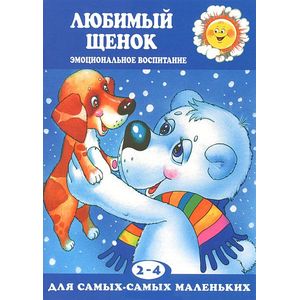Beloved puppy. Emotional upbringing. 2-4 years
Please sign in so that we can notify you about a reply
Your child now comprehends social ties, determines its place in the family. And, accordingly, tests different scenarios of behavior with one or another family member. Requests of a pet, sometimes very persistent, reassessing their strength and opportunities in this regard are also associated with the definition of social status.
Pets, even very small, are additional concerns and troubles mostly for adults. Therefore, parents should think well how much they will burden the care of animals if they go towards the requests of their son or daughter. After all, it is clear that it will be mostly mom to care for the pet.
However, the presence of an animal in the house for a growing kid has its own positive moments.
For a small child, a pet becomes a family member, especially if the parents for animals belong to humane. Therefore, the presence of hamster, fish, cats or dogs is another area of the emotional development of the baby: he will refer to an animal as a friend and, accordingly, build relationships with him.
Pets - participants in children"s games, object of sensory observations. They provide baby the opportunity to expand communication. Children, even if they have not very developed speech, talk to their friend, share challenges and secrets. Communicating with pets, they learn to empathize, understand their needs. A child who has lives in the house will not hurt homeless animals.
Homemade favorite develops a sense of responsibility in a child: daily help (let it still be very small) in feeding and leaving. Someone appears, from you dependent and requiring constant attention. This disciplines, teaches to think not only about himself and raises self-esteem.
Baby only in six years will be able to systematically wash the drink, the feeder, the outer walls of the aquarium under the supervision of adults. At this age and earlier, the child is suitable "small" animals: fish, birds, hamsters, guinea pigs.
In seven or eight years, the child can care for his pet almost independently, even more than a few, if, for example, there is a aquarium and guinea pig or hamster. Cats and dogs are "serious" for animal care, they remain almost entirely on the care of adults.
It is why in our fabulous story a lot of conventions: a small child (and he certainly identifies himself with a bear)) does not walk one, does not leave the house, it is not all responsible for a puppy or a cat. On these conventions, the child will not pay attention. Much more important for him will be conversations on pictures, thinking along with mom over one or another situation, on what the character felt like he did and how it was necessary to do it right. Therefore, read the story without hurrying, consider the pictures, pay attention to the emotional state of the characters, let"s evaluate them. And do it emotionally, enthusiastically and sincere
Pets, even very small, are additional concerns and troubles mostly for adults. Therefore, parents should think well how much they will burden the care of animals if they go towards the requests of their son or daughter. After all, it is clear that it will be mostly mom to care for the pet.
However, the presence of an animal in the house for a growing kid has its own positive moments.
For a small child, a pet becomes a family member, especially if the parents for animals belong to humane. Therefore, the presence of hamster, fish, cats or dogs is another area of the emotional development of the baby: he will refer to an animal as a friend and, accordingly, build relationships with him.
Pets - participants in children"s games, object of sensory observations. They provide baby the opportunity to expand communication. Children, even if they have not very developed speech, talk to their friend, share challenges and secrets. Communicating with pets, they learn to empathize, understand their needs. A child who has lives in the house will not hurt homeless animals.
Homemade favorite develops a sense of responsibility in a child: daily help (let it still be very small) in feeding and leaving. Someone appears, from you dependent and requiring constant attention. This disciplines, teaches to think not only about himself and raises self-esteem.
Baby only in six years will be able to systematically wash the drink, the feeder, the outer walls of the aquarium under the supervision of adults. At this age and earlier, the child is suitable "small" animals: fish, birds, hamsters, guinea pigs.
In seven or eight years, the child can care for his pet almost independently, even more than a few, if, for example, there is a aquarium and guinea pig or hamster. Cats and dogs are "serious" for animal care, they remain almost entirely on the care of adults.
It is why in our fabulous story a lot of conventions: a small child (and he certainly identifies himself with a bear)) does not walk one, does not leave the house, it is not all responsible for a puppy or a cat. On these conventions, the child will not pay attention. Much more important for him will be conversations on pictures, thinking along with mom over one or another situation, on what the character felt like he did and how it was necessary to do it right. Therefore, read the story without hurrying, consider the pictures, pay attention to the emotional state of the characters, let"s evaluate them. And do it emotionally, enthusiastically and sincere
Author:
Author:Frolova G.
Cover:
Cover:Soft
Category:
- Category:Engineering & Transportation
- Category:Parenting & Relationship
Series:
Series: For the most small
ISBN:
ISBN:978-5-9715-0672-0
No reviews found
